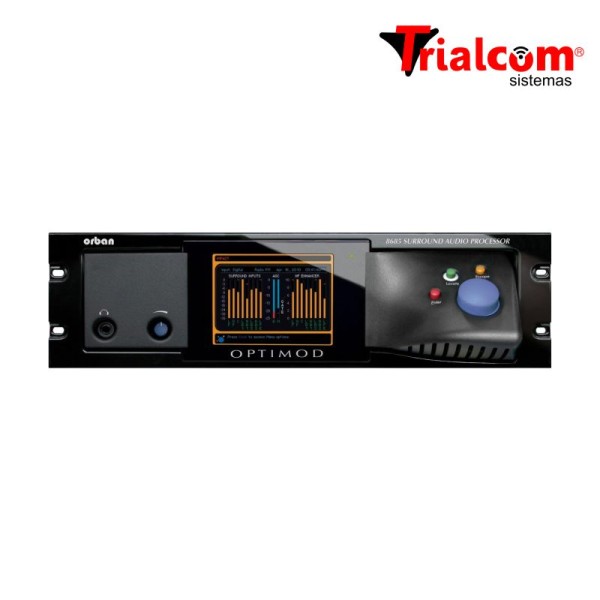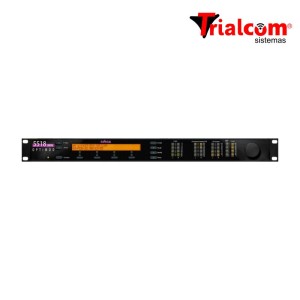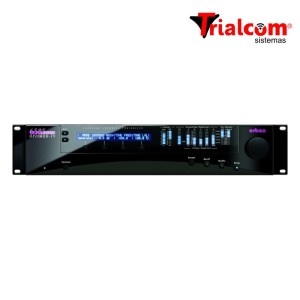Optimod-TV 8685
Optimod 8685 Surround
Orban Television Audio Processing — Sound That Keeps Audiences Listening
The 8685 is Orban’s second-generation surround/2.0 processor. In addition to the effective automatic loudness control of its predecessor, the 8685 offers new input/output capabilities that include support for SDI and HD-SDI and for Dolby E. Dual redundant power supplies help ensure maximum uptime. In addition to surround processing, the 8685 can simultaneously provide up to four channels of 2.0 processing, allowing it to provide all the audio processing necessary for a typical ATSC broadcast with multiple subchannels.
Like the 8585, the 8685 is dialnorm-aware. Loudness control is excellent when measured by the ITU BS.1770-2 and EBU R-128 standards or by the 8685’s built-in CBS Loudness Meters, allowing stations to comply effortlessly with the requirements of the CALM act. An included logging application allows time-stamped indications of the 8685’s built-in BS.1770-2 short-term and integrated loudness meters to be written to a Windows PC’s local or network storage.
Experience has shown that the mass television audience wants two things from television audio: dialog should be comfortably intelligible and commercials should not be irritatingly loud compared to program material. Home theater owners may want the opportunity to watch feature films while hearing a wide dynamic range signal. However, even these viewers usually consume television in a much more passive way when viewing garden-variety programs. To be an acceptable part of the domestic environment, television sound cannot overwhelm household members not interested in viewing (not to mention neighbors, particularly in multi-family dwellings). For a variety of reasons, the dynamic range of sound essential to the intelligibility of the program should not exceed 15 dB in a domestic listening environment. Underscoring and ambient sound effects will, of course, be lower than this.
The issue of loud commercials is particularly important. In the U.S., it is against Federal Communications Commission rules to broadcast irritatingly loud commercials. Because of viewer complaints, the FCC has periodically investigated the problem ever since 1965.
Orban understands such issues well. Since 1980, we have provided analog television broadcasters with industry-standard dynamics processors: Optimod-TV 8180, 8182, 8282, and 8382. In 1998, we introduced Optimod-DAB 6200 — two-channel processing specifically tailored for digital channels using lossy compression like Dolby’s AC-3, which is used for ATSC transmissions. Our 6300, introduced in 2006, is a second-generation two-channel processor for digital channels, including DTV, DAB, and netcasting.
In typical analog television practice, all audio is applied to a single transmission audio processor that automatically controls the average modulation and the peak-to-average ratio while smoothing out transitions between program elements. Simple compression and peak limiting cannot do this effectively. Starting with the 8182, all Optimod-TV processors have incorporated the CBS Loudness Controller™.
Developed after 15 years of psychoacoustic research at CBS Laboratories, the CBS Loudness Controller accurately estimates the amount of perceived loudness in a given piece of program material. If the loudness exceeds a preset threshold, the controller automatically reduces it to that threshold. The CBS algorithm has proven its effectiveness by processing millions of hours of on-air programming and greatly reducing viewer complaints.
In ITU parlance, the CBS Loudness Controller relies on a «short-term» loudness measurement that takes into account the human ear’s loudness integration time — approximately 200 milliseconds. The CBS algorithms attack time is fast enough to prevent audible and irritating loudness overshoots — blasts of sound that have viewers scrambling for their remote controls. Loudness control is always smooth and unobtrusive. Unlike «long-term» loudness measurement and control technologies, the CBS Loudness Controller recognizes that a piece of program material whose average loudness seems acceptable according to a long-term loudness measurement may nevertheless have short sections whose loudness should be reduced because it is extremely annoying. While main purpose of this processing is to control the loudness of commercials, other exuberantly mixed elements can also benefit. A good example is applause with whistling.
Optimod-Surround 8685:
Effective Automatic Loudness Control for Up to 7.1 Channels
For many years our television customers have been asking for Optimod-quality surround sound processing along with the ability to process the local insertion of news, weather and sports independently. Our customers know that there is no substitute for the smooth, natural-sounding control that only Optimod provides, particularly with speech material.
Orban’s response is the 8685. This next generation Optimod provides the functionality and control necessary for up to nine audio streams simultaneously. It can help you achieve the highest audience satisfaction in digital audio broadcasting, digital television, and netcasting.
The 8685 features Optimod-quality two-band and five-band audio processing for surround sound broadcasting and netcasting. Thanks to versatile compression ratio controls and a mastering-quality look-ahead peak limiter, the 8685 is also ideal for mastering audio in broadcast productions as well as productions intended for media such as DVD and Blu-ray.
The 8685 starts with the technology of Orban’s popular Optimod 6300 and takes it to the next level with surround processing that reflects the latest psychoacoustic research into loudness perception. The 8685’s CBS Loudness Controller works in both two-band and five-band modes. Third generation improvements reduce annoyance better than simple loudness control alone, doing so without audible gain pumping.
In July 2011, the ATSC revised its Recommended Practice entitled Techniques for Establishing and Maintaining Audio Loudness for Digital Television (A/85:2011), which recommends use of the ITU-R BS.1770 long-term loudness meter algorithm to measure loudness. We have verified that the CBS Loudness Controller as implemented in the 8685 (as well as in Orban’s two-channel 6300 and 1101 processors) effectively controls long-term loudness as measured by the BS.1770-2, maintaining it within the +2, –5 dB “comfort zone” defined in ATSC A/85 Annex E, thus allowing U.S. broadcasters to comply with the CALM Act. The 8685 also offers a built-in ITU-R BS.1770-2 loudness meter so that users can verify the effectiveness of its loudness control. (BS.1770-2 is based on BS.1770 but adds gating to prevent it from reading too low during material having pauses or silence.)
In our experience, the CBS Loudness Controller and Loudness Meter lock onto the program’s “anchor element” (typically speech) more accurately than the BS.1770 meter, which also tends to over-indicate the loudness of material with low peak-to-RMS ratio (such as promos and commercials with a lot of “artistic compression) by 3 dB or more. Nevertheless, to accommodate organizations that will disqualify an automatic loudness controller if it causes a BS.1770 meter to read higher than a specified threshold, the 8685 now offers a defeatable “BS.1770 safety limiter” that follows the CBS Loudness Controller in the signal path. This limiter can be set to effectively control the indications of a BS.1770-2 gated meter with 10-second or longer integration time. Because gain reduction in the BS.1770 safety limiter is usually triggered by inaccuracies in the BS.1770-2 algorithm itself, we prefer the sound of the processing with this limiter defeated so that all loudness control is performed by the CBS algorithm.
The 8685 is up to nine processors in one, offering four independent 2.0 channel processors plus surround processing for up to 7.1 channels. The 2.0 processing can operate in dual-mono mode, so a given 2.0 processor can process one audio stream in stereo or two audio streams in mono. Each processor includes a CBS Loudness Controller, BS.1770 Safety Limiter, CBS Loudness Meter, and BS.1770-2 Loudness Meter. Additionally, the first 2.0 processor’s output can be mixed into the left and right front channels of the surround processing so that the surround processing’s Loudness Controller and look-ahead limiters control the loudness and peak level of the mix. Meanwhile, the fourth 2.0 processor can receive a stereo downmixed output from the surround multiband compressor. This downmix application uses only the loudness controllers and peak limiter of the 2.0 processor, allowing the stereo downmix to have dedicated, accurate loudness control and peak levels.
The multichannel and 2.0 processors can operate with separate audio processing parameters like release times. For example, one of the 2.0 processors could be set up for relatively heavy processing to make a newsroom feed more consistent, while the surround processing could be set up more conservatively to correct network material and commercials unobtrusively.
Because the 2.0 processors have their own loudness controllers and peak limiters, another important application is processing subchannels in digital television.
The 8685 is built on Orban’s flagship hardware platform. This features a GUI displayed on a quarter-VGA active matrix color LCD, making it easy to do all setup and adjustment from the 8685’s front panel. To minimize latency and to achieve highest reliability, the 8685 uses a dual hardware architecture. Freescale 24-bit DSP chips do all audio processing while a separate microcontroller supports the GUI and control functions. Even if this controller malfunctions, the 8685 will continue to process audio normally. Minimum latency of the fully processed signal is 21 milliseconds, which can be padded to exactly one frame of delay for any video standard. The low latency headphone feed (containing all processing except for peak limiting) has a latency of approximately 6 milliseconds.







